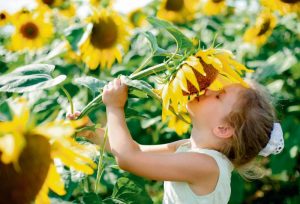Delicate miniatures to towering Giants. Growing sunflowers are totally Awesome!
Sunflowers have an amazing variety of uses. Grown as food for poultry and livestock,
dyes come from the petals, and paper is made from the stalks pith. Sunflower seed feed countless people, animals and birds; seed-oil is used in cooking, soaps and cosmetics. You can grow sunflowers in the garden as a windbreaks, privacy screen or living support for pole beans.
Sunflowers come in many sizzling sizes. Some cultivars grow 15′ tall, with flower heads twice the size of you hands, while dwarfs only reach knee high. Some cultivars produce a single large flower; others form several heads.
high. Some cultivars produce a single large flower; others form several heads.
Planting
Choose a site with 6+ hours of sun on the north side of your garden, these tall flowers want to shade the rest of the gardens, so placement is critical. It’s best to wait until the soil is warmer, around the first warm days of May. Sow seeds 1″ deep and 6″ apart. Water well after planting. Sunflowers have long tap roots which need to stretch out; seedlings prefer well dug, loose, draining soil. Turn the soil to one shovels depth and 3 feet across while blending in a 3 inch layer of Watters Premuim Mulch to insure the soil does not compact.
Growing Guidelines
Once your seedlings are up apply a 3 inch layer of Shredded Cedar Bark to conserve moisture, repel insects and keep weeds down. Sunflowers are drought resistant, but they will grow better if you water 2-3 times per week until the flowers mature.
Food for Bigger Flowers
Sunflowers are heavy feeders so the soil needs to be nutrient rich. For a truly spectacular flower size feed your plant every two weeks with Watters ‘Flower Power 54’ food. This water soluable food ingites the flowers size, brightness and seed count.
Problems
Sunflowers are remarkably trouble-free. Find a new spot to grow sunflowers each year to prevent leaf mottle, a soil fungus that produces dead areas along leaf veins. An early autumn may interfere with pollination and cause the plant to form empty seeds; plant earlier the next year. To protect seeds from birds, cover flowers with mesh bags, cheesecloth, old pantyhose, or perforated plastic bags. Bamboo stakes may be required as the plant stretched above head height.
Harvesting Sunflowers
Harvest as soon as seeds start to turn brown or the backs of the seed heads turn yellow. The heads usually droop at this time. Harvest with a 2 foot stem and hang upside down in a garage or garden shed until fully dried.
Delicious Eats
Dissolve 1/2 cup of table salt in a 1/2 gallon of water, add the sunflower seeds and soak them overnight. Drain and spread on a baking sheet and roast for 3 hours at 200°F or until crisp. Serve them at your next garden party and guests will be wowed that you grew, harvested, and roasted your own sunflower seeds.
Interesting Fact
Someone paid over $39 million in 1987 for Vincent van Gogh’s Sunflowers painting. Kansas is “The Sunflower State.”
Kansas is “The Sunflower State.”

